

The partners of Meeks, Watson & Company are noted for their expertise
of carillon design, having designed, redesigned, or directed alterations
and/or improvements to more than half of the carillons in existence in
North America. We have been involved in many situations requiring creative
solutions to provide instruments in less than ideal towers with much-improved
actions through re-configuration of the bell siting and action arrangements.
Ideally, we should be consulted early on, when a carillon is planned
for a new tower. One notable instance of this was our new carillon of
48 bells for Penn State University, Erie. Throughout the design of the
tower we worked closely with Noelker & Hull, Architects, of Chambersburg,
PA, architects of the Smith Chapel, to insure an ideal coordination of
tower and instrument.
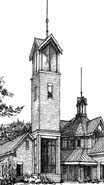 Smith Chapel, Penn State Erie: rendering by Noelker & Hull, Architects |
An early design study for our Smith Chapel carillon |
Where the project involves designing a new instrument
for an older tower, or the renovation and improvement of an existing
instrument, major changes of the tower are generally not possible; however,
we have developed design criteria for improving the configuration of
many such carillons and chimes, making the best acoustic and mechanical
use of the available space and bell chamber configuration. Examples include
the first two instruments ever to make use of the radial configuration
of bells, to coordinate with radial action. The idea of radial configuration
to equalize the length of clapper connections was originated by our firm,
and first used in the rebuilding of the carillons at Iowa State University
and Christ Church Cranbrook. Accompanying photos illustrate this advance
in carillon design, as applied to the latter instrument.
 MW radial beam design, Christ Church Cranbrook |
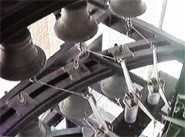 The MW radial beam design, Christ Church Cranbrook, as carried out |
The design of better configurations for the bells of carillons in towers of unusual design, often with bell chambers of limited space, has been our challenge in many cases. Two that might be cited are Texas Tech University, Lubbock, where a complete refitting of the existing carillon provided the occasion for a complete redesign of the instrument. Note in the accompanying drawing how the bells have been configured to work with the shape of the bell space, rather than at cross purposes to it.
 Texas Tech carillon level 3 plan drawing |
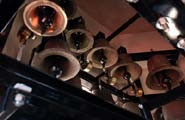 Texas Tech carillon level 3-4 photo |
The other example is that of the 49 bell Eijsbouts carillon of First Presbyterian Church, Gastonia, NC, where the original design, though visually interesting, led to overly long clapper connections, and prevented the use of any kind of protective screening for the exclusion of birds. Our renovation reconfigured the instrument completely within the unusual triangular bell chamber footprint, solving both problems, while also achieving full access to all parts for future service and adjustment.
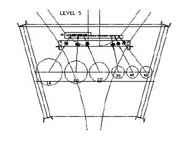 First Presbyterian, Gastonia: level 5 plan |
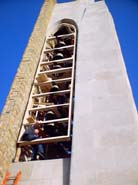 First Presbyterian, Gastonia: re-installing carillon in new configuration |
This sort of expertise is available to you...we welcome
inquiries from carillonneurs, architects, builders, and of course owners
of existing towers. We look forward to working with you to insure the
complete success of new instruments; or in crafting a Meeks, Watson & Company
solution for improvement of existing carillons and chimes.
From the placement and outfitting of the single church bell up to planning the largest carillon, we offer complete design and consulting services. We are as near as your computer or telephone!
